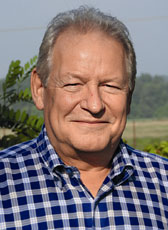Rock River Laboratory, Inc. in Wisconsin

Donald Meyer, founder and CEO of Rock River Laboratory, Inc.
Rock River Laboratory, Inc. was founded in 1976 by Donald Meyer in Watertown, Wisconsin. As a studied geographer, he was interested in the combination of science and analysis. The laboratory started as a soil analysis laboratory but quickly expanded into analyzing feed, water, and manure. The Watertown site is ideal; it is located in the heart of the American dairy industry in Wisconsin and close to the leading university in its field, the University of Wisconsin-Madison. With this connection new research can find its way into the field.
Rock River Laboratory team members also work for the  university which ensures an excellent exchange of knowledge. Rock River Laboratory was among the first laboratories to use NIR commercially. Donald Meyer is a member of the NIR Consortium and the USDA-NIR Forage Network. Rock River Laboratory can look back on 40 years of experience in feed analysis for high-producing dairy cows in the USA. Rock River Laboratory is characterized by its close proximity to the customer, as the employees “understand cows”. From practical nutritional advice to presentations as speakers; numerous publications, including the Journal of Dairy Science, document their scientific quality. It is important not only to analyze the core nutrients, but to see how these values help the farmers improve their herd performance.
university which ensures an excellent exchange of knowledge. Rock River Laboratory was among the first laboratories to use NIR commercially. Donald Meyer is a member of the NIR Consortium and the USDA-NIR Forage Network. Rock River Laboratory can look back on 40 years of experience in feed analysis for high-producing dairy cows in the USA. Rock River Laboratory is characterized by its close proximity to the customer, as the employees “understand cows”. From practical nutritional advice to presentations as speakers; numerous publications, including the Journal of Dairy Science, document their scientific quality. It is important not only to analyze the core nutrients, but to see how these values help the farmers improve their herd performance.
Dr. John Goeser, head of the research and innovation department at Rock River Laboratory says, “The evaluation of the forage potential for digestion can be assessed using analytical tools such as Dynamic CNCPS that describes the total digestibility of NDF (TTNDFD) and the digestion of the starch in the rumen.“ Dr. John Goeser’s focus is on carbohydrate digestion, basic feed management, and feed hygiene.
The analyses are mostly conducted in Germany according to US standards with NIR spectroscopy. The values are controlled and approved by Rock River Laboratory’s USA employees. The quality of the laboratory work and the accuracy of the data are checked every time. Further developments in the calibration using new, professional knowledge are seamlessly integrated into the current calibration program via the cloud.

Dr. John Goeser combines practical work with science. His publications expand the knowledge in the field of NDF and starch Digestibility.

Feeding trail at the Wisconsin-Madison University

Rock River Laboratory, Inc. in Wisconsin/USA

View into the analytical lab







